Abstract
This paper is designed to give an overview of the mechanism of androgen action and some of the factors that can affect it. The discussion of androgen action includes androgen transport in the blood, metabolism, receptor binding, nuclear activation and selected aspects of biological response. The importance of recognizing interspecies and interstrain differences in specific aspects of androgen action is mentioned. Some examples of the effects of environmental agents on androgen metabolism, receptor binding and biological response are included.
Full text
PDF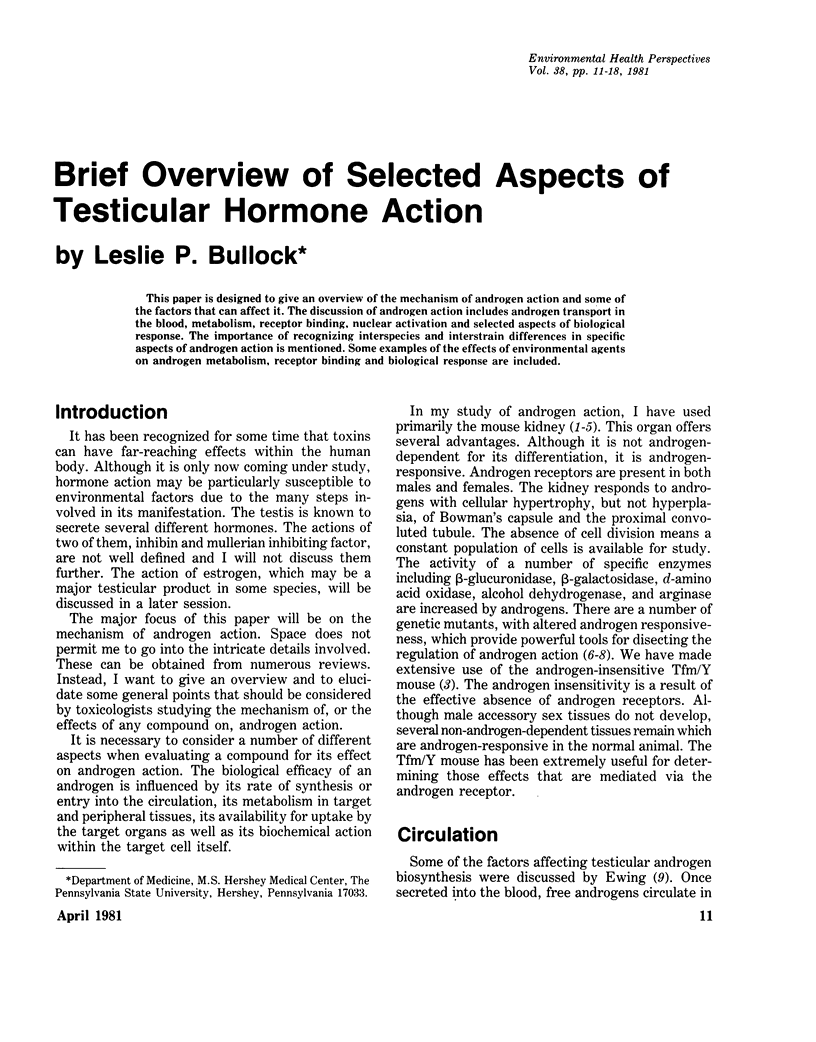
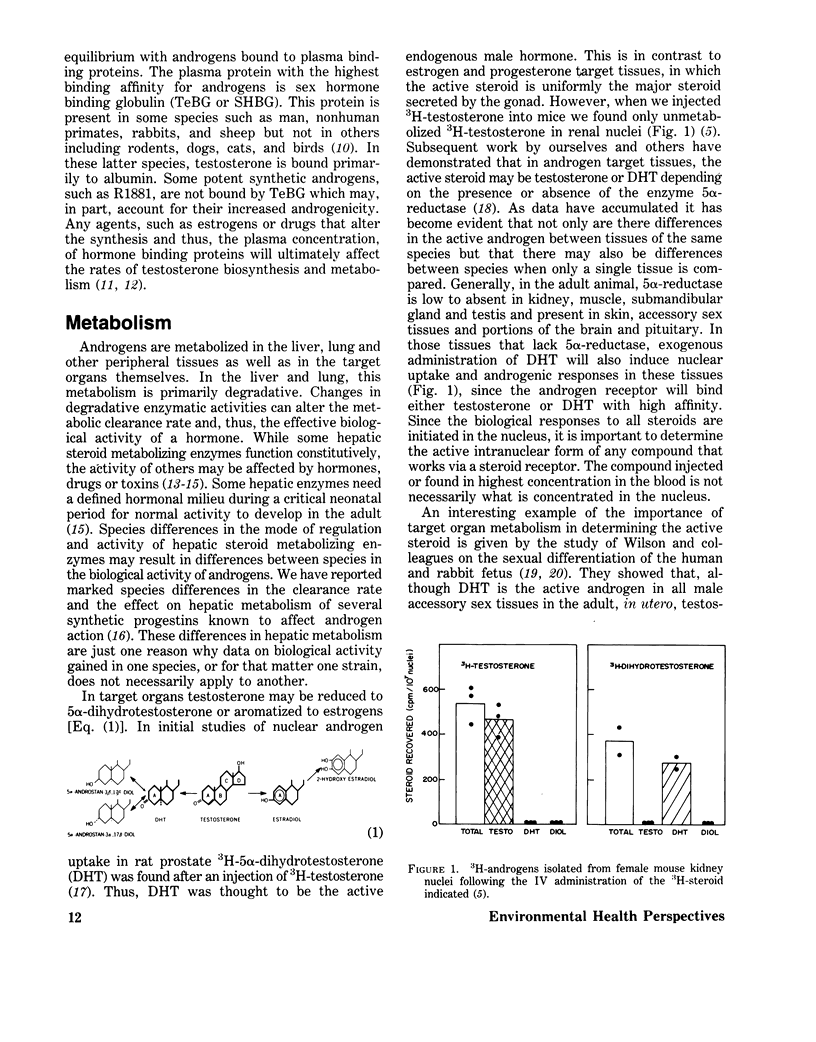

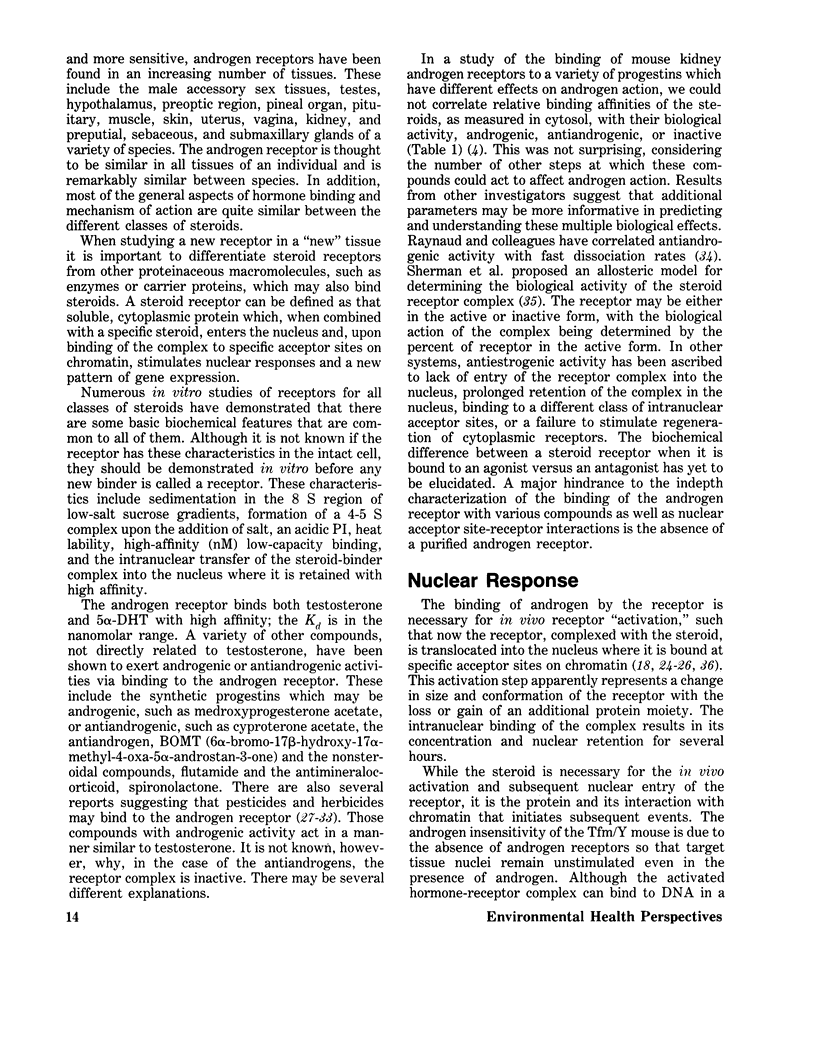
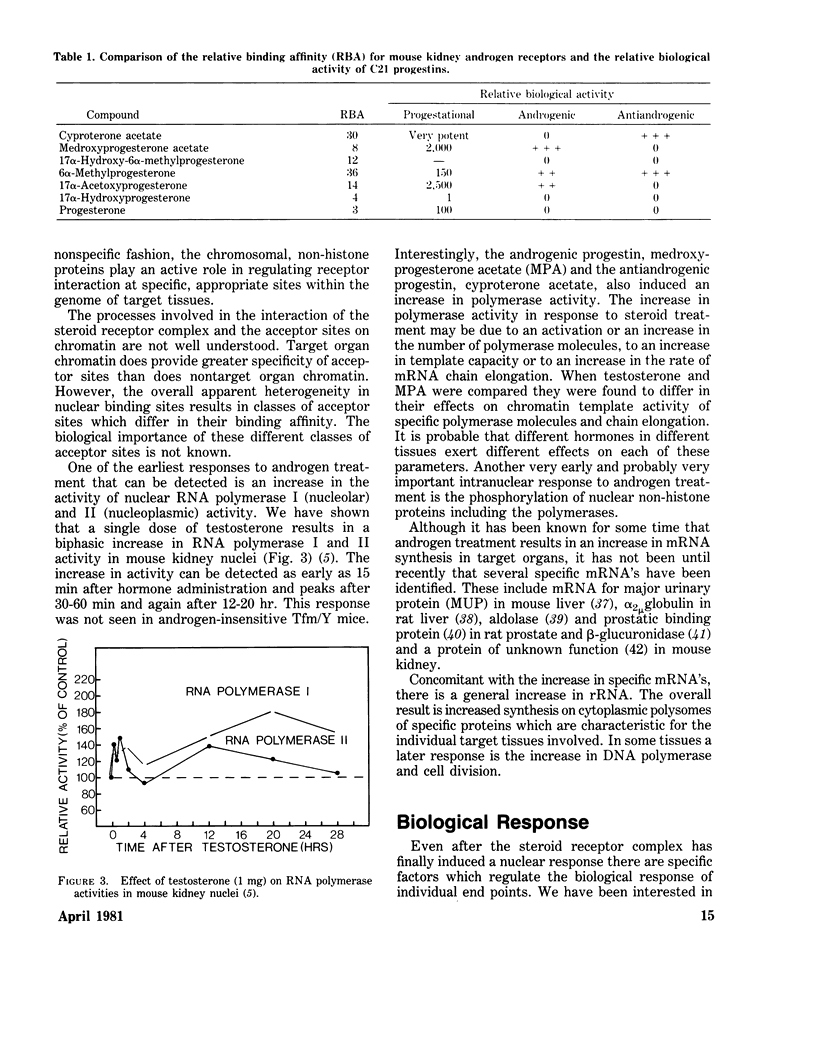
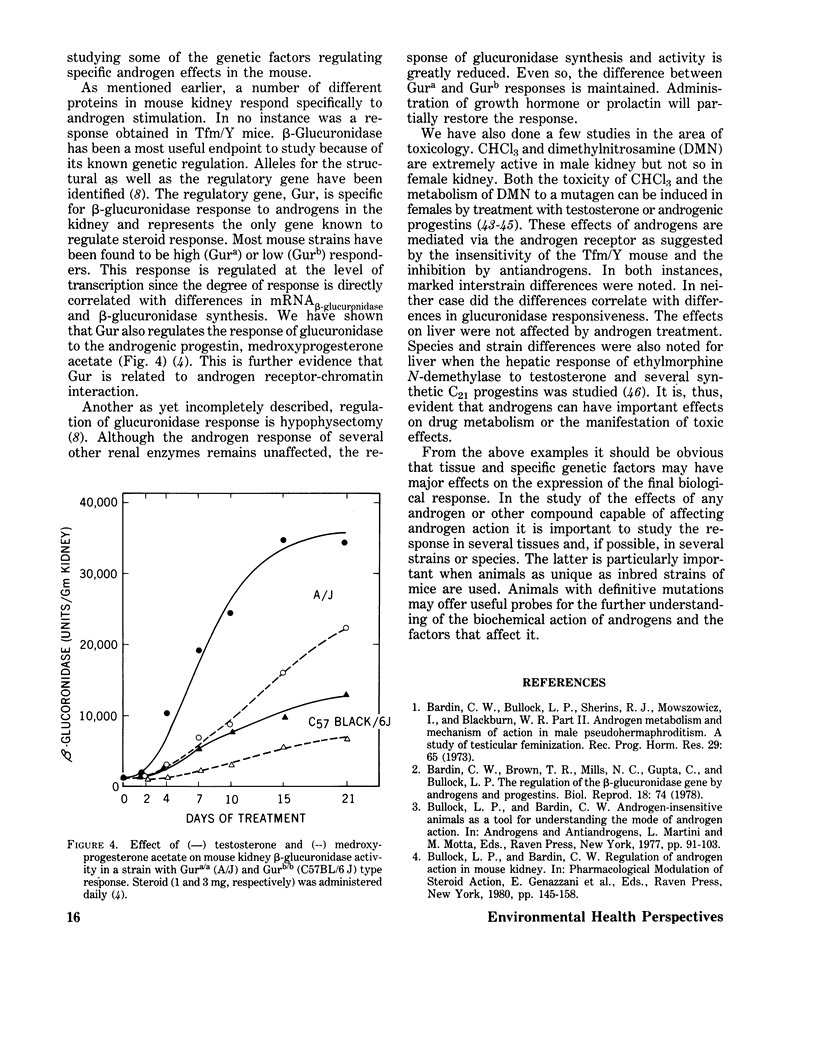


Selected References
These references are in PubMed. This may not be the complete list of references from this article.
- Bardin C. W., Brown T. R., Mills N. C., Gupta C., Bullock L. P. The regulation of the beta-glucuronidase gene by androgens and progestins. Biol Reprod. 1978 Feb;18(1):74–83. doi: 10.1095/biolreprod18.1.74. [DOI] [PubMed] [Google Scholar]
- Bardin C. W., Bullock L. P., Sherins R. J., Mowszowicz I., Blackburn W. R. Androgen metabolism and mechanism of action in male pseudohermaphroditism: a study of testicular feminization. Recent Prog Horm Res. 1973;29:65–109. doi: 10.1016/b978-0-12-571129-6.50006-3. [DOI] [PubMed] [Google Scholar]
- Blend M. J. In vitro uptake of labeled androgens by prostate tissue in the presence of dieldrin. Bull Environ Contam Toxicol. 1975 Jan;13(1):80–85. doi: 10.1007/BF01684868. [DOI] [PubMed] [Google Scholar]
- Brandt E. J., Elliott R. W., Swank R. T. Defective lysosomal enzyme secretion in kidneys of Chediak-Higashi (beige) mice. J Cell Biol. 1975 Dec;67(3):774–788. doi: 10.1083/jcb.67.3.774. [DOI] [PMC free article] [PubMed] [Google Scholar]
- Brown T. R., Bardin C. W., Greene F. E. Mouse liver N-demethylase activity. Sex differences and androgen responsiveness. Pharmacology. 1978;16(3):159–169. doi: 10.1159/000136762. [DOI] [PubMed] [Google Scholar]
- Bruchovsky N., Wilson J. D. The intranuclear binding of testosterone and 5-alpha-androstan-17-beta-ol-3-one by rat prostate. J Biol Chem. 1968 Nov 25;243(22):5953–5960. [PubMed] [Google Scholar]
- CONNEY A. H., SCHNEIDMAN K., JACOBSON M., KUNTZMAN R. DRUG-INDUCED CHANGES IN STEROID METABOLISM. Ann N Y Acad Sci. 1965 Mar 12;123:98–109. doi: 10.1111/j.1749-6632.1965.tb12248.x. [DOI] [PubMed] [Google Scholar]
- Chan L., O'Malley B. W. Mechanism of action of the sex steroid hormones (first of three parts). N Engl J Med. 1976 Jun 10;294(24):1322–1328. doi: 10.1056/NEJM197606102942405. [DOI] [PubMed] [Google Scholar]
- Corvol P., Bardin C. W. Species distribution of testosterone-binding globulin. Biol Reprod. 1973 Apr;8(3):277–282. doi: 10.1093/biolreprod/8.3.277. [DOI] [PubMed] [Google Scholar]
- Deshpande A. K., Chatterjee B., Roy A. K. Translation and stability of rat liver messenger RNA for alpha 2 mu-globulin in Xenopus oocyte. The role of terminal poly(A). J Biol Chem. 1979 Sep 25;254(18):8937–8942. [PubMed] [Google Scholar]
- Hastie N. D., Held W. A., Toole J. J. Multiple genes coding for the androgen-regulated major urinary proteins of the mouse. Cell. 1979 Jun;17(2):449–457. doi: 10.1016/0092-8674(79)90171-5. [DOI] [PubMed] [Google Scholar]
- Labarca C., Paigen K. MRNA-directed synthesis of catalytically active mouse beta-glucuronidase in Xenopus oocytes. Proc Natl Acad Sci U S A. 1977 Oct;74(10):4462–4465. doi: 10.1073/pnas.74.10.4462. [DOI] [PMC free article] [PubMed] [Google Scholar]
- Lloyd J. W., Thomas J. A., Mawhinney M. G. 2,4,5 T and the metabolism of testosterone-1,2- 3 H 2 by mouse prostate glands. Arch Environ Health. 1973 Apr;26(4):217–220. doi: 10.1080/00039896.1973.10666259. [DOI] [PubMed] [Google Scholar]
- Mainwaring W. I., Mangan F. R., Irving R. A., Jones D. A. Specific changes in the messenger ribonucleic acid content of the rat ventral prostate gland after androgenic stimulation. Evidence from the synthesis of aldolase messenger ribonucleic acid. Biochem J. 1974 Nov;144(2):413–426. doi: 10.1042/bj1440413. [DOI] [PMC free article] [PubMed] [Google Scholar]
- Naftolin F., Ryan K. J., Davies I. J., Reddy V. V., Flores F., Petro Z., Kuhn M., White R. J., Takaoka Y., Wolin L. The formation of estrogens by central neuroendocrine tissues. Recent Prog Horm Res. 1975;31:295–319. doi: 10.1016/b978-0-12-571131-9.50012-8. [DOI] [PubMed] [Google Scholar]
- Novak E. K., Swank R. T. Lysosomal dysfunctions associated with mutations at mouse pigment genes. Genetics. 1979 May;92(1):189–204. doi: 10.1093/genetics/92.1.189. [DOI] [PMC free article] [PubMed] [Google Scholar]
- Peterson R. E., Imperato-McGinley J., Gautier T., Sturla E. Male pseudohermaphroditism due to steroid 5-alpha-reductase deficiency. Am J Med. 1977 Feb;62(2):170–191. doi: 10.1016/0002-9343(77)90313-8. [DOI] [PubMed] [Google Scholar]
- Raynaud J. P., Bouton M. M., Moguilewsky M., Ojasoo T., Philibert D., Beck G., Labrie F., Mornon J. P. Steroid hormone receptors and pharmacology. J Steroid Biochem. 1980 Jan;12:143–157. doi: 10.1016/0022-4731(80)90264-2. [DOI] [PubMed] [Google Scholar]
- Rothschild M. A., Kreek M. J., Oratz M., Schreiber S. S., Mongelli J. G. The stimulation of albumin sythesis by methadone. Gastroenterology. 1976 Aug;71(2):214–220. [PubMed] [Google Scholar]
- Siiteri P. K., Wilson J. D. Testosterone formation and metabolism during male sexual differentiation in the human embryo. J Clin Endocrinol Metab. 1974 Jan;38(1):113–125. doi: 10.1210/jcem-38-1-113. [DOI] [PubMed] [Google Scholar]
- Smith M. T., Thomas J. A., Smith C. G., Mawhinney M. G., Lloyd J. W. Effects of DDT on radioactive uptake from testosterone-1,2- 3 H by mouse prostate glands. Toxicol Appl Pharmacol. 1972 Sep;23(1):159–164. doi: 10.1016/0041-008x(72)90215-3. [DOI] [PubMed] [Google Scholar]
- Swank R. T., Paigen K., Davey R., Chapman V., Labarca C., Watson G., Ganschow R., Brandt E. J., Novak E. Genetic regulation of mammalian glucuronidase. Recent Prog Horm Res. 1978;34:401–436. doi: 10.1016/b978-0-12-571134-0.50015-6. [DOI] [PubMed] [Google Scholar]
- Thomas J. A., Lloyd J. W., Smith M. T., Mawhinney M. G., Smith C. G. Effect of dieldrin on the accumulation and biotransformation of radioactive testosterone by the mouse prostate gland. Toxicol Appl Pharmacol. 1973 Dec;26(4):523–531. doi: 10.1016/0041-008x(73)90290-1. [DOI] [PubMed] [Google Scholar]
- Toole J. J., Hastie N. D., Held W. A. An abundant androgen-regulated mRNA in the mouse kidney. Cell. 1979 Jun;17(2):441–448. doi: 10.1016/0092-8674(79)90170-3. [DOI] [PubMed] [Google Scholar]
- Wakeling A. E., Schmidt T. J., Visek W. J. Effects of dieldrin on 5 -dihydrotestosterone binding in the cytosol and nucleus of the rat ventral prostate. Toxicol Appl Pharmacol. 1973 Jun;25(2):267–275. doi: 10.1016/s0041-008x(73)80013-4. [DOI] [PubMed] [Google Scholar]
- Wakeling A. E., Visek W. J. Insecticide inhibition of 5alpha-dihydrotestosterone binding in the rat ventral prostate. Science. 1973 Aug 17;181(4100):659–661. doi: 10.1126/science.181.4100.659. [DOI] [PubMed] [Google Scholar]


